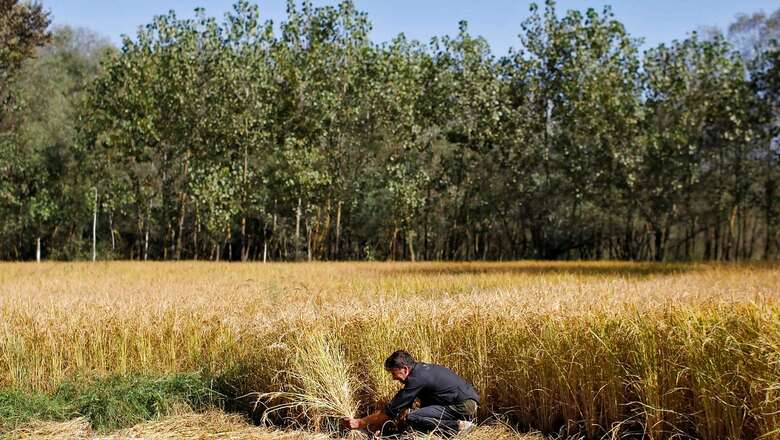
views
As the world grapples with increasingly complex problems posed by climate change, the Indian government is scaling up action to take on the challenges that the country will face in the coming decade. While the past few years have been focused on the transition to renewable energy, Budget 2022-23 has begun a new era for climate action in India. In the Budget, the administration proposes a greater focus on delivering policy incentives for organic farming, agroforestry and private forestry for farmers and indigenous communities across the country.
Agroforestry is gaining global attention for its role in battling climate change. Agriculture today is responsible for a third of the world’s emissions, from farm to fork. Industrialised agriculture’s focus on chemical farming and monoculture plantations deplete soils and biodiversity on lands, reducing the total carbon sequestered in an area. By comparison, agroforestry sequesters an estimated 34 per cent more carbon in soil. Agroforestry also demands lesser use of inputs like fertilizer, as complementary natural crops and systems naturally nourish the soil — healthier agri-ecosystems also sequester more carbon than degraded ones.
A Changing Rural Economy
Since the liberalisation reforms of the early ‘90s, India’s agricultural incomes have been on the decline. Rural youth are increasingly moving out of farming, looking for employment in non-farm sectors. Most of these jobs have been concentrated in the construction sector, but the disruptions of COVID-19 lockdowns have made this a precarious sector. The alternative at home, however, is marginal incomes driven by low productivity and rising desertification.
The problem is worst for marginal and smallholder farmers, who barely have enough land to break even. Many of these farmers continue farming because they have no alternatives and no opportunities. Schemes designed to protect farmer incomes, such as minimum support prices, have no impact on these smallholder farmers as they rarely can access the mandisand formal markets where these schemes are implemented. As young people move out of farming in search of better jobs, India faces mounting risks to its overall food security – bad news at a time when national hunger and food insecurity are on the rise. Existing data also suggests that non-rural employment is not expanding fast enough to absorb the young people moving away from farming.
If there is an answer to be found to these multiple dilemmas – jobs for rural youth, better farming incomes – it lies in fundamentally rethinking how we practice agriculture. Today the landscape is dominated heavily by monoculture farming, with government subsidies encouraging farmers to move towards chemical-based cultivation of genetically modified seeds. Overall, productivity remains low and the intensification of chemical use depletes the soil of its nutrients, compounding the growing desertification crisis.
Revitalising Rural Economies through Agroforestry
Agroforestry allows farmers even with extremely marginal holdings to benefit. In a total of 0.3 acres of land, a farmer can grow up to eight crops simultaneously, from lucrative cash crops such as pepper and ginger, to nutritious food crops such as pumpkin, moringa and sweet potato. Studies indicate that agroforestry in tropical countries like India improves overall land productivity by up to 56 per cent, simply by optimising land use.
When piloted in a scientifically constructed food forest model, the complementary crops simulate natural organic conditions, cycling nutrients back into the soil and minimising the need for water use. These ecological benefits enhance the natural ecosystem supporting agricultural cultivation, creating a naturally self-regenerating system – and diminishing the expenditures needed to invest in fertilizers and other chemical inputs.
On average, agroforestry can generate a 40 per cent increase in household income in farming communities that largely practice subsistence level agriculture. In Baligaon Miri Green village in Sonitpur district, Assam, the creation of food forests on empty lands belonging to indigenous communities has provided maximum benefit by optimally leveraging soil, water and sunlight that flourishes without any human interference – producing ample food, healthy growth and contributing to a balanced ecosystem. Within months, villagers in the community gained an additional Rs 18,000 in income through agroforestry, increasing their overall earnings from Rs 13,000 per month to over Rs 30,000. During the numerous COVID-19 lockdowns, migrants returning from their jobs in the cities soon found agroforestry a lucrative alternative that also offered greater social stability and a lower cost of living.
A Regenerative Future
The case study of Baligaon demonstrates how agroforestry can help communities become self-sufficient and food secure while improving incomes for farmers through increased productivity. In India’s North East alone, agroforestry earnings would generate Rs 36,045 crore annually if the agricultural land was optimised. Investing these earnings back in the community could deliver universal basic assets such as healthcare, education, energy, water access to over 500,000 households – with spending on healthcare and education matching international OECD standards. More broadly, the earning opportunities would create greater avenues for rural youth to find secure and stable employment within their communities, enhancing overall rural wellbeing.
India’s new interest in agroforestry is a step in the right direction. New incentives need to be tailored keeping the needs of marginal farmers in mind. Their lack of access to formal markets or licensed mandis means new delivery channels need to be built for price support. Subsidies need to be climate-smart, tailored to local conditions and needs, elevating indigenous and local crops, and providing robust crop insurance mechanisms for vulnerable farmers. More direct economic support needs to be directed toward supporting agroforestry, along with support for rural entrepreneurship in value addition packaging, processing and branding on local produce. Caution is also critical: agroforestry cannot replace natural biodiverse forests which play a vital role in keeping the rural ecosystem healthy and functional.
As the country faces a future of climate uncertainty – erratic monsoons, flooding, heatwaves – only an ecologically restorative transition to achieve greater productivity yields can secure livelihoods for marginal farmers. A biodiversity-smart, climate-smart approach through agroforestry is a low-hanging fruit we must invest in to create new, better and sustainable jobs for rural youth. The future of marginal farmers depends on our willingness to invest in a sustainable transformation.
Ranjit Barthakur is a Founder Trustee of Balipara Foundation. The views expressed in this article are those of the author and do not represent the stand of this publication.
Read all the Latest Opinion News and Breaking News here



















Comments
0 comment